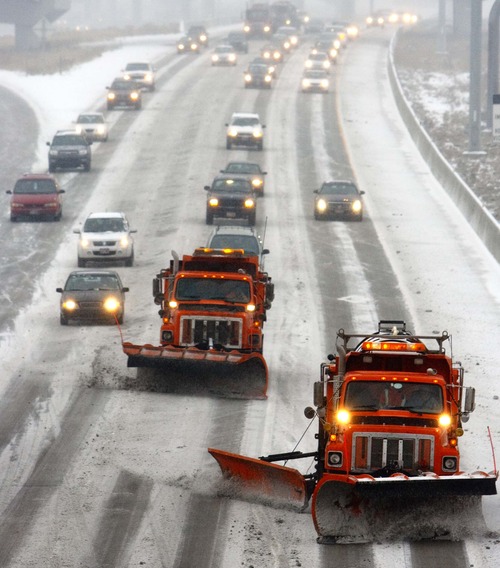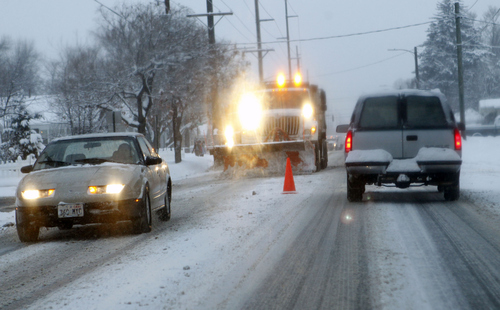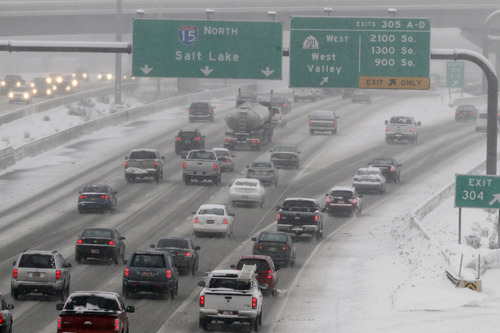This is an archived article that was published on sltrib.com in 2013, and information in the article may be outdated. It is provided only for personal research purposes and may not be reprinted.
Salt Lake Valley residents have had plenty of opportunities this frosty season to enjoy snow. But as snow-removal efforts kicked into high gear, cities' budgets to keep streets clean are going pretty fast, if they are not gone already.
"We're very careful, and most cities in the state understand that we can budget everything in the world, but the biggest wild card is snow removal," said John Park, city manager for Cottonwood Heights, which has a snow-removal budget of $400,000.
Park said the city estimated it spent $129,000 of that budget by the end of December. In January, the Wasatch Front received an abundance of snow, and at the end of the month, Cottonwood Heights already exhausted its snow-removal budget.
"It's impossible to predict," Park said. "Last year it was very dry, and two years ago, we had a very wet, late winter."
Although the set budget has melted, Park said not to worry as state law requires cities to keep rainy-day funds.
"We have plenty of money in our reserve," he said.
Using that fund will eliminate some of the road projects in the spring and summertime, but Park said it's just a give and take. Plus, snow isn't all bad.
"Snow is always welcome," he said. "We like drinking water and all that."
Last year, Cottonwood Heights spent a little more than $200,000 for snow removal. Like other cities, it has a contract with Salt Lake County, which provides Cottonwood Heights with 11 snowplows, salt, tools, manpower, etc.
"When you're talking about dealing with limited resources, it's manpower and equipment," Park said. "It's more of a juggling act."
So why doesn't the city consider adding more workers and trucks? According to Park, the topic comes up often enough, but due to the unpredictable nature of weather, the city would rather do with what it's got.
"We talk about it all the time, and it's about balance," Park said. "Last year we would have a lot of men and equipment doing nothing."
Public-services director Doug Hill of Murray said his city is likely to exceed its snow-removal budget.
"We usually get more snow in February and March," Hill said. "We budget every year $75,000 for buying salts, and as of [January] we have spent $55,000."
Hill said if there's money left from street, water or sewer projects, the city uses that, but if there's not, it has to ask for funds from the mayor and city council.
The city has 25 employees who operate snowplows and $24,000 for overtime pay this year; that amount already has been exceeded.
"I think Murray residents have come to expect that their roads will be cleared, and I do think we do a good job of keeping the roads in Murray city cleared," Hill said.
Similar story for the city of Holladay as its snow-removal budget of $300,000 is nearly consumed by early February.
"We're not able to do what we plan to do if worse comes to worst," said Tosh Kano, Holladay's public-works director.
In addition to cutting back warm-weather projects such as asphalt paving repair, Kano said it's possible to dig into next year's snow-removal fund. Another option is to ask for credit from Salt Lake County.
"The nice thing about our relationship with the county is the county is on the calendar year, and we're on the fiscal year," Kano said. "We go from July to June."
The difference makes it more convenient for the city to borrow money and pay the county back in the new year.
"It depends on the weather condition," Kano said. "If it continues like this, we're probably going to have to ask for credit."
Last winter, Holladay spent $110,000 for snow removal, which is less than half of its budget.
In Midvale, Doug Ervin, public-works operations superintendent, said about 90 percent of salt supplies and 50 percent of materials like plow blades had been used as of mid-February.
According to Ervin, the Midvale snowplows only went out for one shift last winter season, but the abundance of snow this year doesn't strike him as too much.
"I budget the same for a normal winter, and I believe this year is just a normal winter," Ervin said. "We live in Utah, and we're supposed to get this many inches of snow."
Twitter: @sltribMid









